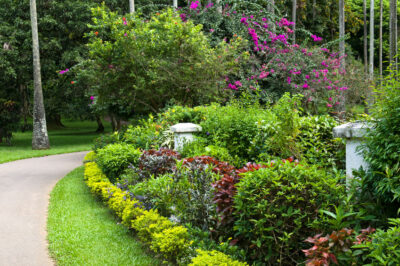
Creating a wildlife-friendly garden is a rewarding project that not only enhances the beauty of your backyard but also provides essential habitat for local wildlife. By selecting and planting trees and shrubs, you can create a sanctuary that supports birds, pollinators, and other beneficial creatures. Here are some tips on how to help you transform your garden into a wildlife haven.
Planning Your Wildlife-Friendly Garden
- You should start by assessing your garden space and identifying sunny and shady areas, soil type, and moisture levels. This will help you select the right plants that will thrive in your specific conditions.
- Decide what types of wildlife you want to attract. Different plants will attract different species, so having a clear goal will guide your plant selection. For example, if you want to attract birds, consider berry-producing shrubs and trees with dense foliage for nesting.
- Plan where you will place trees, shrubs, water features, and other elements. Consider creating layers with tall trees at the back, medium-sized shrubs in the middle, and ground cover or smaller plants at the front. This will mimic natural habitats and provides diverse shelter and food sources.
Select the Right Trees and Shrubs
Native plants are best for wildlife gardens as they have evolved alongside local wildlife and provide the most appropriate food and shelter. Research native trees and shrubs that are well-suited to your region.
Select a variety of plants that offer different benefits:
- Berry-producing shrubs (e.g., elderberry, serviceberry) for birds.
- Nectar-rich flowers (e.g., flowering dogwood, redbud) for pollinators.
- Evergreens (e.g., eastern red cedar) for year-round cover and food.
Ensure Year-Round Interest Choose plants that provide food and shelter throughout the year. This means including evergreens for winter cover, spring, and summer flowering plants for pollinators, and fall berry producers for migrating birds.
Prepare the Planting Area
It’s important to remove any weeds, grass, and other debris from the area you will be planting your garden. The current soil may need to be tilled and prepped for a healthy planting environment. You never want to plant your garden in a bad area with hard ground. You can always add some fresh topsoil to ensure that your garden will start off strong. Incorporate organic matter like compost to create a healthy growing environment. Ensuring you have the proper watering system set up for your garden at the beginning is crucial for the start of it. You can use a drip system, or you can make sure you’re manually watering consistently.
Planting Trees and Shrubs
If you’re using bare root trees, soak the roots in water for a few hours before planting. Position the tree so the roots are spread out naturally in the hole. Fill the hole with soil, making sure the tree is planted at the same depth it was grown in the nursery.
For container-grown shrubs, gently tease out the roots if they are pot-bound. Place the shrub in the hole and backfill with soil, firming it down gently. Water thoroughly after planting to settle the soil.
The Benefits of Building Your Own Wildlife-Friendly Garden
Having any type of DIY project is always going to be fulfilling. Watching your garden grow over the summer months is not only rewarding, but it is always an exciting experience. It can be very challenging to make sure everything is planted correctly, as well as watered regularly for nutrients. Of course, with any type of garden, you must deal with all the pests and problems that may come along with it, but these are all good challenges for you.
By carefully planning, selecting native plants, and incorporating various wildlife-friendly features, you can create a thriving habitat that supports birds, pollinators, and other creatures. Not only will your garden become a beautiful and vibrant space, but it will also play a crucial role in promoting biodiversity and ecological health in your area.
At Cold Stream Farm, we can provide you with a variety of trees and shrubs for your garden at our wholesale farm in Michigan. Contact us today at (231) 464-5809 for more information or visit us online to take a look at our trees and shrubs inventory!
